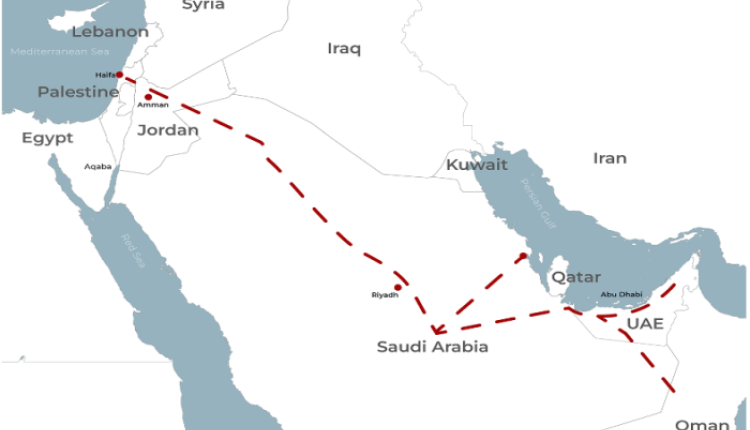Normalization Corridor: The Saudi–Zionist “Pipeline Project” to Plunder the Nation’s Wealth and Encircle the Resistance Axis
Amid the rapidly shifting regional dynamics and Washington’s ongoing attempts to reengineer the Middle East in service of the Zionist entity, the Hebrew daily Maariv has unveiled a new normalization project that transcends economics to strike at the core of regional sovereignty and security — a U.S.-backed (though unofficial) regional energy corridor linking the occupied territories with Saudi Arabia.
A dangerous scheme, the project seeks to cement the Zionist entity as the regional hub for energy and geopolitical dominance, while turning Gulf states into dependent transit routes serving the occupation’s interests — far removed from the aspirations of their own peoples.
Hegemony Disguised as “Regional Cooperation”
According to Maariv, the so-called “Israeli Energy Minister,” Eli Cohen, announced his entity’s intention to establish an energy corridor stretching from the Gulf to the occupied territories — connecting Asia to Europe through Palestinian land — with the goal of transforming “Israel” into the regional energy hub.
Cohen explained that this corridor would serve as “an alternative route to passing through Iranian territory or the Suez Canal,” effectively aiming to bypass Iranian and Egyptian influence while marginalizing independent Arab states — all in service of U.S. and Zionist agendas.
A Hidden Agenda: An Economic Façade for Colonial Ambitions
Though marketed as an “economic initiative,” analysts and observers stress that the project is part of a broader normalization campaign with deep security and strategic implications. Washington aims to integrate the Zionist entity into a joint Arab economic framework as a prelude to an overt political and military alliance against the Axis of Resistance.
Experts note that the plan would allow the Zionist entity to infiltrate Gulf economies and link their infrastructure to that of the occupation — effectively subordinating the region’s economic and sovereign decision-making to the U.S.–Israeli system, while the wealth of the Arab world is drained under banners of “stability and development.”
Saudi Arabia: From Partner to Functional Corridor
The new initiative underscores a dangerous transformation in Saudi Arabia’s regional role — from a partner in Western projects to a functional passageway directly serving Zionist interests. This comes especially after Riyadh’s participation in the aggression against Yemen and its facilitation of military and logistical routes in support of the enemy.
Observers view Saudi involvement in such projects as clear evidence of deepening security and political convergence with the Zionist entity — not only in normalization efforts but also in confronting the Resistance Axis across Yemen, Palestine, Lebanon, Syria, and Iran.
Timing: Zionist Crisis and an Attempt to Escape Forward
The revelation of this project comes at a time when the Zionist entity faces its worst internal, political, and security crises since its establishment — suffering battlefield losses in Gaza and growing regional pressure from Yemen, Lebanon, Iraq, and Iran.
Experts argue that this announcement is nothing more than an attempt by the Zionists to “escape forward,” masking military defeat behind illusory “regional integration” schemes — even as popular Arab rejection of normalization surges, especially after the horrific massacres committed by the occupation in Gaza.
Normalization Corridor: A Pipeline of Plunder and Control
Analysts describe the project as an updated version of the “Deal of the Century,” repackaged in economic form. Its purpose: to open new channels for looting Arab energy resources and linking them to occupation networks, ensuring the continuous flow of wealth to Tel Aviv and Washington while depriving regional nations of development and sovereignty.
The proposed corridor poses a direct threat to Arab and Islamic national security, granting the Zionist entity strategic control over energy routes and trade corridors — effectively dictating the political choices of dependent states.
The Resistance: The Obstacle to Normalization Schemes
Conversely, observers affirm that the Axis of Resistance — led by Yemen — remains the biggest obstacle to the success of these normalization schemes, thanks to its steadfastness, principled opposition to U.S.-Israeli domination, and military operations that have reshaped the balance of power in the Red Sea and Arabian Sea.
While certain regimes seek to appease Washington and Tel Aviv, the free peoples of Yemen, Iran, Lebanon, and Palestine continue to assert that the region’s future cannot be built on submission to occupiers, but on the foundations of liberation, independence, and sovereignty.
A New Front for U.S.–Zionist Expansion
Ultimately, the so-called “Energy Corridor Project” is nothing more than a new façade for extending U.S.–Zionist influence across the region — at a moment when both Washington and Tel Aviv face mounting exposure and disarray in the face of the Resistance Axis’s rise.
Yet just as the free peoples of the region have thwarted every “New Middle East” scheme before, the collective consciousness and steadfast resistance of the ummah will dismantle every corridor of normalization and betrayal — keeping Palestine the true compass, and Yemen the steadfast pillar of freedom and defiance against hegemony.

